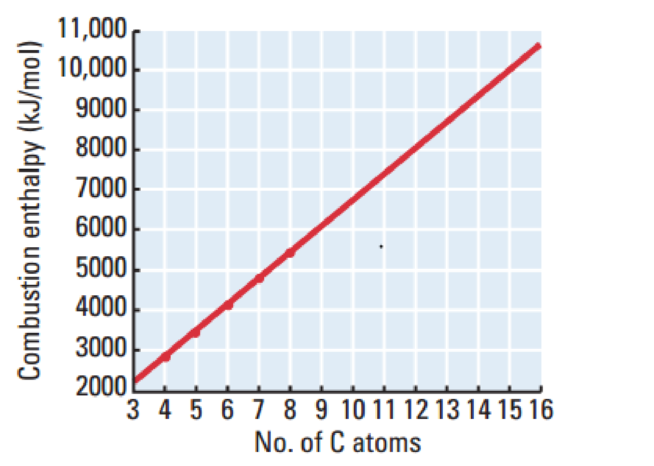
Concept explainers
(a)
Interpretation:
The enthalpy of combustion of propane, nonane, and hexadecane has to be predicted with help of graphical method.
Concept Introduction:
The amount of energy which is produced or absorbed during the reaction is the enthalpy change of a
(a)
Answer to Problem 124QRT
The enthalpy of combustion of propane
Explanation of Solution
The given data table is shown below.
| Hydrocarbon | Formula | Enthalpy if combustion (kJ/mol) |
| Butane | ||
| Pentane | ||
| Hexane | ||
| Heptane | ||
| Octane |
The graph has been plotted between enthalpy of combustion on the

Figure 1
When the number of carbon atom is
Therefore, the enthalpy of combustion of propane
When the number of carbon atom is
Therefore, the enthalpy of combustion of nonane
When the number of carbon atom is
Therefore, the enthalpy of combustion of hexadecane
(b)
Interpretation:
The reason as to why the slope of graph enthalpy of combustion on the
Concept Introduction:
Refer to part (a).
(b)
Answer to Problem 124QRT
The graph has positive slope because bond enengy increases as the number of carbon increases.
Explanation of Solution
The given data table is shown below.
| Hydrocarbon | Formula | Enthalpy if combustion (kJ/mol) |
| Butane | ||
| Pentane | ||
| Hexane | ||
| Heptane | ||
| Octane |
The graph has been plotted between enthalpy of combustion on the

Figure 1
This graph has positive value.
The combustion of hydrocarbons involves breaking of
The bond enthalpy for
The bond enthalpy for
The number of bonds
Want to see more full solutions like this?
Chapter 10 Solutions
Chemistry: The Molecular Science
- Complete and balance the following combustion reactions. Assume that each hydrocarbon is converted completely to carbon dioxide and water. (a) Propane + O2 (b) Octane + O2 (c) Cyclohexane + O2 (d) 2-Methylpentane + O2arrow_forwardUsing a table of average bond enthalpies. Table 6.2 ( Sec. 6-6b), estimate the enthalpy change for the industrial synthesis of methanol by the catalyzed reaction of carbon monoxide with hydrogen.arrow_forward(a) Calculate the standard enthalpy change for the combustion of 1 mol of benzene, C6H61l2, to CO21g2 and H2O1l2.(b) Compare the quantity of heat produced by combustion of 1.00 g propane with that produced by 1.00 g benzene.arrow_forward
- determine the number of valence electrons in ethene (C₂H₄) and then draw the corresponding Lewis structure.arrow_forwardWhen 13.0 g of acetylene, C2H2, undergoes complete combustion, 65.5 kJ of heat are released. a) How much energy is released when one mole of acetylene is burned? b) Write a balanced chemical equation for the reaction and include the heat value in the equation.arrow_forwardEthanol, C₂H60, is most often blended with gasoline - usually as a 10 percent mix - to create a fuel called gasohol. Ethanol is a renewable resource and ethanol-blended fuels, like gasohol, appear to burn more efficiently in combustion engines. The combustion of one mole of ethanol releases 326.7 kcal of energy. The combustion of one mole of 2-methylheptane, C8H18, releases 1.306 × 10³ kcal of energy. How much energy is released during the complete combustion of 405 grams of 2- methylheptane? kcal Assuming the same efficiency, would 405 grams of ethanol provide more, less, or the same amount of energy as 405 grams of 2-methylheptane? more less the same amount Retry Entire Group 9 more group attempts remainingarrow_forward
- Consider the complete combustion of octane. Calculate the bond energies (in kJ/mol) for the:Combustion of methane CH4(g)+2O2(g)→CO2(g)+2H2O(g)a. bonds brokenb. bonds formedc. overall reactionarrow_forwardAlcohols A, B, and C all have the composition C4H10O. Molecules of alcohol A contain a branched carbon chain and can be oxidized to an aldehyde; molecules of alcohol B contain a linear carbon chain and can be oxidizedto a ketone; and molecules of alcohol C can be oxidized to neither an aldehyde nor a ketone. Write the Lewis structures of these molecules.arrow_forward(a) What is the difference between chlorofluorocarbons and hydrofluorocarbons?arrow_forward
- a) Calculate the heat evolve when the ethanol was combusted b) Calculate the enthalpy change of combustion per mole of ethanolarrow_forwardA student added bromine solution to a hydrocarbon sample that contained an isomer of C6H12 (E) in the absence of light. After shaking the sample, the student noticed that the colour of the bromine solution changed from orange to colourless. Use the following information to answer the question 6. An interpretation that could be made from the student's observations is that the hydrocarbon sample isi and the IUPAC name of the sample could be ii . The statement above is completed by the information in row: i saturated saturated unsaturated unsaturated Row A B C D wer (2 marks) ii hex-2-ene cyclopentane hex-2-ene cyclopentane 0arrow_forwardMTBE, Methyl tert-butyl ether, CH3OC(CH3)3, is used as an oxygen source in oxygenated gasolines. MTBE is manufactured by reacting 2-methylpropene with methanol.(a) Using Lewis structures, write the chemical equation representing the reaction.(b) What volume of methanol, density 0.7915 g/mL, is required to produce exactly 1000 kg of MTBE, assuming a 100% yield?arrow_forward
 Chemistry & Chemical ReactivityChemistryISBN:9781337399074Author:John C. Kotz, Paul M. Treichel, John Townsend, David TreichelPublisher:Cengage Learning
Chemistry & Chemical ReactivityChemistryISBN:9781337399074Author:John C. Kotz, Paul M. Treichel, John Townsend, David TreichelPublisher:Cengage Learning Chemistry & Chemical ReactivityChemistryISBN:9781133949640Author:John C. Kotz, Paul M. Treichel, John Townsend, David TreichelPublisher:Cengage Learning
Chemistry & Chemical ReactivityChemistryISBN:9781133949640Author:John C. Kotz, Paul M. Treichel, John Townsend, David TreichelPublisher:Cengage Learning Chemistry: The Molecular ScienceChemistryISBN:9781285199047Author:John W. Moore, Conrad L. StanitskiPublisher:Cengage Learning
Chemistry: The Molecular ScienceChemistryISBN:9781285199047Author:John W. Moore, Conrad L. StanitskiPublisher:Cengage Learning Organic ChemistryChemistryISBN:9781305580350Author:William H. Brown, Brent L. Iverson, Eric Anslyn, Christopher S. FootePublisher:Cengage Learning
Organic ChemistryChemistryISBN:9781305580350Author:William H. Brown, Brent L. Iverson, Eric Anslyn, Christopher S. FootePublisher:Cengage Learning Chemistry: Principles and PracticeChemistryISBN:9780534420123Author:Daniel L. Reger, Scott R. Goode, David W. Ball, Edward MercerPublisher:Cengage Learning
Chemistry: Principles and PracticeChemistryISBN:9780534420123Author:Daniel L. Reger, Scott R. Goode, David W. Ball, Edward MercerPublisher:Cengage Learning




